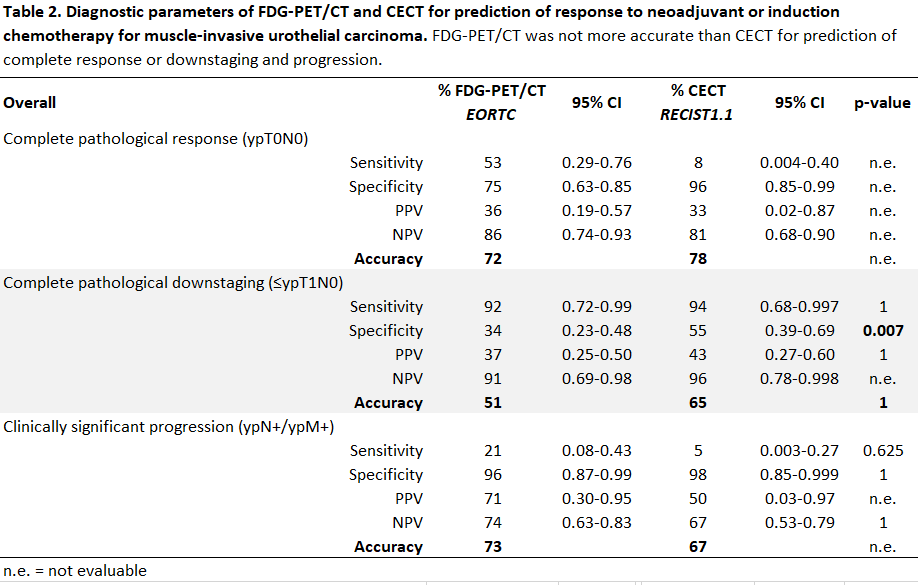Back
Poster, Podium & Video Sessions
MP03: Bladder Cancer: Invasive I
MP03-06: Prospective study on FDG-PET/CT for On-treatment Assessment of Response to Neoadjuvant or Induction Chemotherapy in Invasive Bladder Cancer
Friday, May 13, 2022
7:00 AM – 8:15 AM
Location: Room 222
Sarah Einerhand*, Charlotte Voskuilen, Elies Fransen van de Putte, Maarten Donswijk, Annemarie Bruining, Michiel Van der Heijden, Laura Mertens, Kees Hendricksen, Erik Vegt, Bas van Rhijn, Amsterdam, Netherlands
- SE
Poster Presenter(s)
Introduction: Neoadjuvant/induction chemotherapy (NAIC) for muscle-invasive bladder carcinoma (MIBC) has been shown to improve survival. On-treatment response assessment aims to detect chemo-(in)sensitive tumors to continue or cease NAIC. We compared accuracy of FDG-PET/CT to contrast-enhanced CT (CECT) for on-treatment assessment of response to NAIC.
Methods: We prospectively included 83 patients with MIBC in 2014-2018 (study protocol: X14BSB). Patients staged as (high-risk) cT2-4N0M0 or cT1-4N+M0-1a were eligible for neoadjuvant (n=40; 48%) or induction (n=43; 52%) chemotherapy, respectively. Response was assessed after 2-3 cycles with FDG-PET/CT (n=83) and CECT (n=60; 72%). FDG-PET/CT images were assessed by 2 nuclear medicine physicians (Peter Mac criteria). CECT images were assessed by 1 radiologist (RECIST1.1 criteria). We assessed prediction of complete pathological response (pCR; ypT0N0), complete pathological downstaging (pCD; =ypT1/is/1N0), any downstaging from baseline (ypTN
Results: In this cohort, pathological response rates were 21% for pCR, 29% for pCD, 49% for any downstaging, and 10% progressed. All diagnostic parameters for FDG-PET/CT and CECT are shown in Table 1. Accuracy of FDG-PET/CT for prediction of pCR, pCD, any downstaging and progression were 74%, 54%, 61% and 83%, respectively. Accuracy of CECT for prediction of pCR, pCD, any downstaging and progression were 78%, 63%, 68% and 77%, respectively. Specificity of CECT was significantly higher than FDG-PET/CT for prediction of any downstaging (59% vs 32%; p=0.022). In all other analyses, there were no significant differences between FDG-PET/CT and CECT (Table 1).
Conclusions: FDG-PET/CT was not more accurate than CECT for assessment of response to NAIC. However, neither were highly accurate and response was often overestimated. Our results suggest more accurate methods for on-treatment response assessment are needed to accurately select patients for continued treatment with NAIC and surgery.
Source of Funding: None

Methods: We prospectively included 83 patients with MIBC in 2014-2018 (study protocol: X14BSB). Patients staged as (high-risk) cT2-4N0M0 or cT1-4N+M0-1a were eligible for neoadjuvant (n=40; 48%) or induction (n=43; 52%) chemotherapy, respectively. Response was assessed after 2-3 cycles with FDG-PET/CT (n=83) and CECT (n=60; 72%). FDG-PET/CT images were assessed by 2 nuclear medicine physicians (Peter Mac criteria). CECT images were assessed by 1 radiologist (RECIST1.1 criteria). We assessed prediction of complete pathological response (pCR; ypT0N0), complete pathological downstaging (pCD; =ypT1/is/1N0), any downstaging from baseline (ypTN
Results: In this cohort, pathological response rates were 21% for pCR, 29% for pCD, 49% for any downstaging, and 10% progressed. All diagnostic parameters for FDG-PET/CT and CECT are shown in Table 1. Accuracy of FDG-PET/CT for prediction of pCR, pCD, any downstaging and progression were 74%, 54%, 61% and 83%, respectively. Accuracy of CECT for prediction of pCR, pCD, any downstaging and progression were 78%, 63%, 68% and 77%, respectively. Specificity of CECT was significantly higher than FDG-PET/CT for prediction of any downstaging (59% vs 32%; p=0.022). In all other analyses, there were no significant differences between FDG-PET/CT and CECT (Table 1).
Conclusions: FDG-PET/CT was not more accurate than CECT for assessment of response to NAIC. However, neither were highly accurate and response was often overestimated. Our results suggest more accurate methods for on-treatment response assessment are needed to accurately select patients for continued treatment with NAIC and surgery.
Source of Funding: None

.jpg)
.jpg)